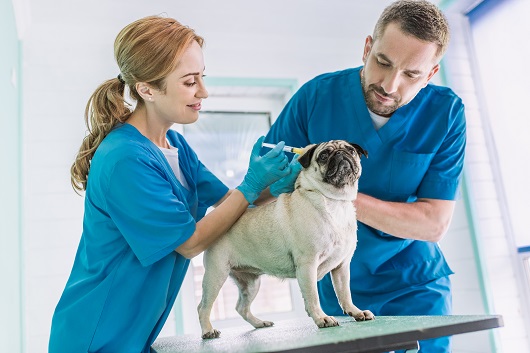A vaccine for a particular disease is a serum that constitutes weakened cells of the pathogen or virus. By introducing weakened/dead pathogens, the body of the receiver starts making antibodies against the pathogen. Thus, it allows the vaccinated person/animal to resist the disease, reduce its effects, and save lives.
This article provides a brief summary of everything you should know about vaccinating your dog, including core vaccinations, vaccination schedule, vaccine report card, consulting your veterinarian, and side effects.
It would be best if you gave several vaccines to your dogs to stay safe against life-threatening diseases that will cause them a lot of pain and suffering.
The Canine Task Force of the American Animal Hospital Association has announced five vaccines, namely to be designated as core vaccines. Core vaccines are essential as they protect against diseases that can affect them anywhere globally, irrespective of their breed and age. These are namely –
- Canine Distemper – A viral disease that results in fatal gastrointestinal, nervous, and respiratory problems
- Canines Parvovirus – A fatal viral disease attacking bone marrow and intestinal tract. It spreads rapidly by direct and indirect contact
- Rabies – A deadly viral disease that can spread to humans and other dogs through the infected dog’s saliva. Once caught, it is untreatable and results in death
- Leptospirosis – A bacterial disease affecting liver and kidneys
- Hepatitis – A viral disease that affects the liver
There are also non-core vaccines administered, but it usually depends upon the dog’s age, breed, health, and atmosphere or condition. These include- Canine influenza, Lyme vaccine, and Bordetella.
When should you start vaccinating your dog?
Vaccination should start when the puppy is aged between 6 to 8 weeks old and stops having their mother’s milk. If you adopt an adult dog, you must ask for its vaccination report card.
All the core vaccines are administered when the dog stays as a puppy until they reach 1 to 2 years of age. Then, when the dog turns into an adult, the veterinarian injects ‘boosters’ periodically.
Core-Vaccination Schedule
As a puppy:
Between 6 – 7 weeks: Bordetella, DHPP
9-10 weeks: Leptospirosis, Bordetella, DHPP
12-13 weeks: Leptospirosis, Lyme disease /Canine Influenza, DHPP
15-17 weeks: Rabies, Canine influenza/Lyme disease, DHPP.
As Adult:
Within one year of age: Boosters of DHPP, Rabies, Canine Influenza / Lyme disease, Leptospirosis
It is vital that you dutifully maintain your dog’s vaccination report card so that every vaccine and booster gets administered on the correct date.
Consult your veterinarian –
This article is a brief introduction to your dog’s vaccination. Of course, you must always consult your veterinarian before appointing for a vaccination.
Every dog does not need to be vaccinated against every disease, whereas some dogs need double vaccination for parvo. Hence, consulting your veterinarian and a check-up of your dog is extremely important before vaccination.
Side effects
It is common for any living being, whether a human, dog, cat, or horse, to have side effects after vaccination. Usually, after vaccination, the side effects include soreness, maybe a little hair loss at the point of injection, sleepiness, fever, diarrhea, and nausea.
However, if your dog is getting seriously ill, consult your veterinarian immediately.
Do not delay vaccination. Please consult your vet about your dog’s vaccine and give it the gift of a healthy life.

 DogExpress
DogExpress



















 in Chandigarh, India.
in Chandigarh, India. 
